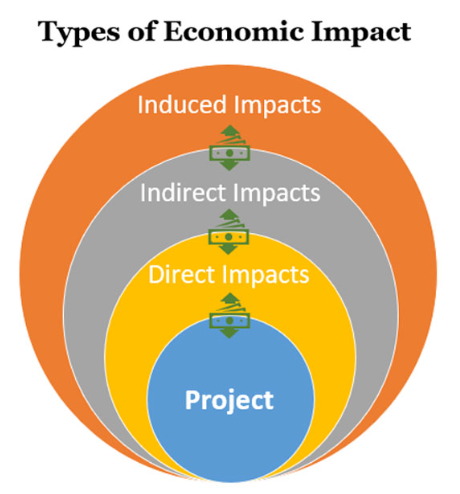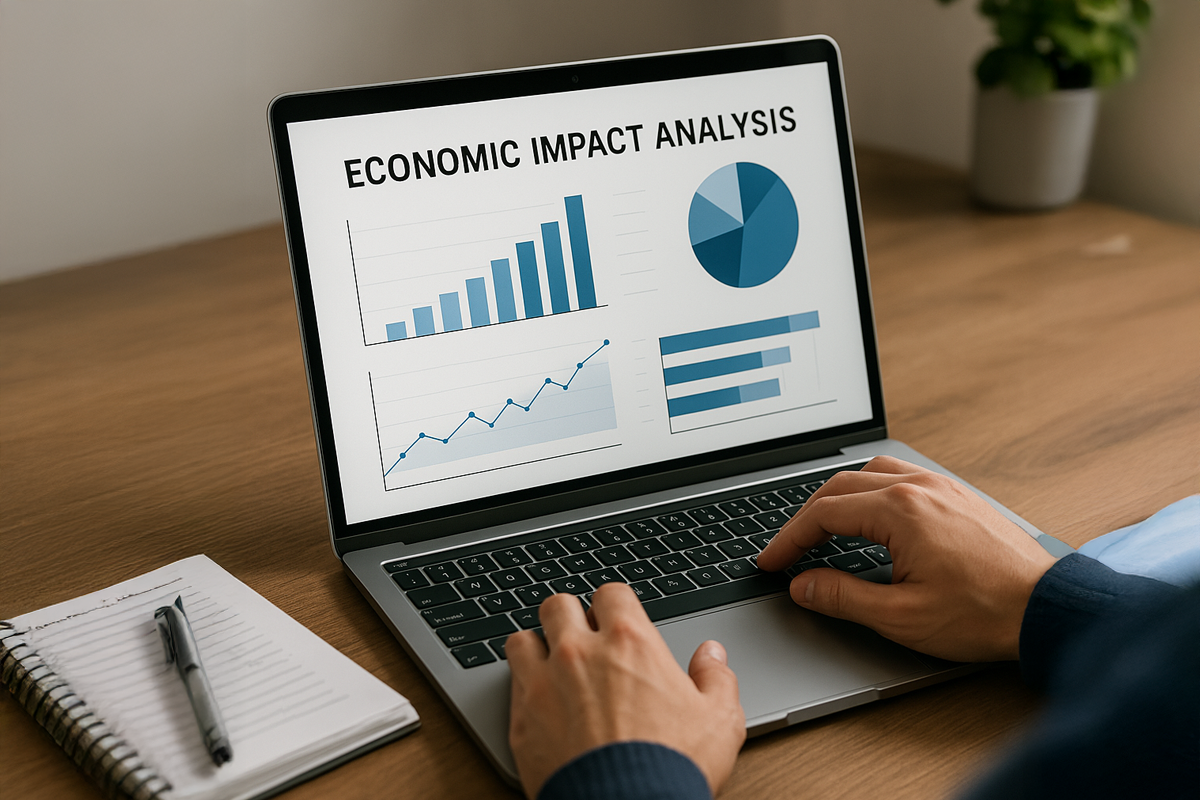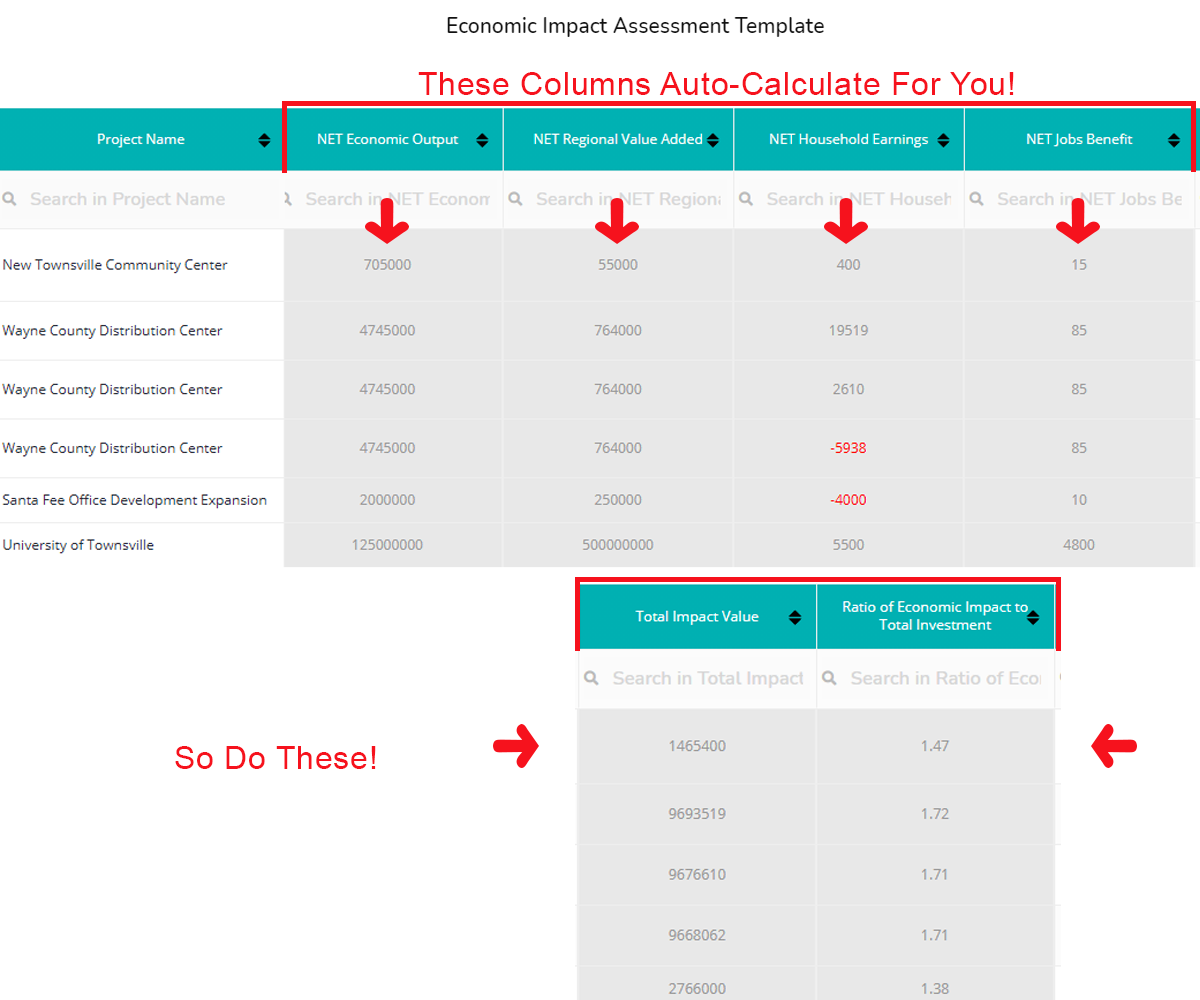Your Exclusive Roadmap to Mastering the Tools of Economic Analysis
Ever wonder how a new factory, a massive music festival, or even a shift in government policy can impact the entire economy of a region? Understanding macroeconomic effects is essential for responsible decision-making and economic impact assessment.
In a world where every major project creates a cascade of economic changes, truly understanding those changes can be the difference between wildly successful investments and incredibly costly mistakes.

This article is your guide to understanding these crucial macroeconomic effects. By the time you’re done reading, you’ll grasp how to accurately measure these far-reaching impacts, helping you create better impact assessments.
From the latest economic analysis tools to real-world economic analysis samples, you’ll discover how to transform complex economic relationships into clear insights that drive better decisions.
What’s in this Economics Effects Guide?
- What is Economic Impact Analysis? (Direct, Indirect, Induced)
- How Do You Measure the Economic Impact of a Project?
- Essential Tools of Economic Analysis
- How to Calculate Economic Impact: Step-by-Step Process
- Economic Analysis Models: Choosing the Right Approach
- Types of Economic Impacts
- Real-World Economic Analysis Examples
- Advanced Economic Analysis Techniques
- Best Practices for Economic Impact Analysis
- Tools of Economic Analysis Conclusion
- Macroeconomic Effects FAQ:
What is Economic Impact Analysis? (Direct, Indirect, Induced)
Economic impact analysis measures how a specific project, event, policy, or business change affects the broader economy within a defined geographic area or industry sector. Think of it as creating a financial ripple effect map showing not just the immediate splash, but all the waves that follow.
The field has evolved significantly in recent years. The Bureau of Economic Analysis’s economic modeling tools now incorporate updated benchmark data, reflecting ongoing improvements in analytical capabilities available to practitioners.
Modern economic impact analysis goes beyond simple job creation numbers. Today’s assessments examine complex interdependencies, account for displacement effects, and integrate real-time economic data to provide more accurate predictions than ever before.

Understanding macroeconomic effects requires grasping three fundamental impact types that form the backbone of any comprehensive analysis:
Direct Economic Impact Definition
Direct economic impact definition encompasses the immediate economic activity generated by a project or event. When a new manufacturing plant opens, the direct impacts include:
- Wages paid to employees
- Payments to local suppliers for materials
- Contracts with service providers
For example, if a hospital expansion creates 200 new positions with an average salary of $65,000, the direct impact on wages would be $13 million annually. Similarly, purchasing $2 million in medical equipment from regional suppliers represents direct economic output impact.
Indirect Economic Impact Definition
Indirect economic impact definition covers the secondary economic activity that occurs when businesses benefiting from direct spending make their own purchases. These effects ripple through the supply chain, often crossing industry boundaries.
Using our hospital example, the medical equipment supplier might hire additional staff to meet increased demand, purchase more raw materials, or expand their facilities. These secondary purchases create indirect economic impacts that extend far beyond the original hospital investment.
Induced Economic Effects
In this review of economic analysis for a hospital expansion, what would be induced economic impacts? Induced impacts result from household spending by employees who earn income from direct and indirect economic activity. When hospital workers and supply chain employees spend their paychecks on housing, food, entertainment, and other goods and services, they create additional economic activity throughout the region.
This economic base multiplier effect means that every dollar of direct impact typically generates additional indirect and induced effects, amplifying the total economic impact of any project or event.
This is a key concept in how to measure economic impact, because if you’re not estimating the indirect or induced macroeconomic effects, you could literally be leaving money on the table in an economic impact assessment.
How Do You Measure the Economic Impact of a Project?
Part of how you define economic impact is to understand what factors of financial impacts you’re going to be analyzing. In addition to capturing the total investment/project expenditures, you’ll want to be sure that any economic impact assessment template you use accounts for four key measurement areas.
Key areas for an economic impact analysis template:
- Economic output
- Regional value-added
- Jobs and Their Annual Value
- Household earnings
AssessmentsTools example of economic impact analysis tool
Economic Output
The economic output of a project may also be referred to as business revenue for the businesses supplying products or services for the project.
For example, the economic output includes all materials, labor, and services needed to fulfill a project, thus they would mean positive economic impacts on those supplying those items.
When building a distribution warehouse, you would need construction materials, temporary labor, and other items that would mean sales revenue for local suppliers of those items.
The revenue generated for businesses from those project purchases would be included in your economic output when doing an economic impact study.
Regional Value Added
The economic impact analysis definition of a regional value-added measurement is an estimate of the impact on the gross regional product for the geographical area that you’re assessing.
For example, in an economic benefit analysis a regional value-added for the expansion of a museum could be the overall estimated increase in tourism dollars it would bring to the region.
You could also express regional value added as the overall benefit to the population, for example, if you were building a new hospital in a city that had none, there would be a value added in terms of more expedient healthcare.
The things you include in the regional value added category will depend heavily on the type of project or event that is being assessed using standard economic analysis methods.
Jobs and Their Annual Value
What is the economic impact happening for the available jobs in the area? This category of economic assessment is fairly straightforward. You perform economic analysis example to calculate the value of jobs being added as a result of the project.
You also need to calculate the number of jobs that may be lost due to the project. Some projects will have both positive and negative job impact.
For example, if you’re opening a new restaurant, you may create 50 new jobs. But if you take business away from an existing restaurant, it may cause them to have to lay off 15 workers, so the net economic impact would be +35 jobs.
You then use economic impact analysis methodology to calculate the average annual income for those jobs so you can factor that into the total.
Household Earnings
Household earnings takes the jobs calculation of an economic assessment a step farther. You may be creating jobs, but are you also increasing the average household earnings of the region?
If you’re paying less than the average household earnings, an increase in job number might not necessarily mean that you’ve contributed positively to the economy as a whole.
On the other hand, if your project raises the average wages in the area, then you would be positively impacting household earnings. Some consider this a more accurate measurement of economic impacts than number of new jobs.
When measuring the economic impact of a project, having tools of economic analysis with examples that enable you to input data and get real-time analytics can significantly reduce the time it takes for an economic assessment.
Please let us know if you have questions about economic analysis samples, the economic base multiplier, or how to calculate the multiplier effect. We’ll be happy to help!
Essential Tools of Economic Analysis
The landscape of economic analysis tools has evolved dramatically, offering practitioners more sophisticated options than ever before. Understanding which tools of economic analysis fit your specific needs is crucial for conducting accurate assessments.
Leading Economic Analysis Software
IMPLAN remains the gold standard for comprehensive economic impact modeling. IMPLAN’s software provides precise, reliable insights into job creation and economic impact, with enhanced visualization capabilities and real-time data integration. The platform now makes it easier to communicate findings to stakeholders through improved reporting features. One drawback is that is tends to be expensive, so isn’t always an option for individuals or smaller businesses.
RIMS II (Regional Input-Output Modeling System) continues as the Bureau of Economic Analysis’s free alternative. Regional input–output multipliers such as the RIMS II multipliers allow estimates of how economic activity increases in a particular region will impact other industries. While less sophisticated than commercial alternatives, RIMS II provides reliable multipliers for basic impact assessments that you might use in an economic analysis Excel.
REMI (Regional Economic Models Inc.) offers comprehensive econometric modeling capabilities, integrating input-output analysis with economic forecasting models. These models range from simple systems to sophisticated AI-powered integrated input-output economic impact analysis models.
AssessmentsTools offers an software that uses an easy-to-use economic analysis Excel-type input interface and real-time charts and graphics. This software is currently being updated to significantly improve the assessment experience, with AI-smart assessments, automated cost impact analysis, and more.
Specialized Analysis Applications
Different project types require tailored approaches to economic analysis:
Event Economic Impact Calculator tools have become increasingly sophisticated, incorporating real-time visitor spending data, hotel occupancy rates, and seasonal adjustment factors. These specialized calculators help festivals, conferences, and sporting events quantify their economic contributions more accurately.
Economic impact analysis software now integrates demographic data, infrastructure capacity assessments, and long-term development planning tools. This holistic approach helps municipalities understand not just immediate impacts, but sustainable growth patterns.
Health economic analysis tools have gained prominence, especially following recent global health challenges. These specialized applications evaluate healthcare interventions, public health programs, and medical facility investments using advanced metrics.
How to Calculate Economic Impact: Step-by-Step Process
Conducting thorough economic impact analysis requires systematic data collection and analysis. Here’s the comprehensive process used by professional economists:
Step 1: Define Project Scope and Geographic Boundaries
Begin by clearly defining what you’re analyzing and where. Are you examining a new retail development’s impact on a specific county? A festival’s effect on a metropolitan area? Geographic boundaries significantly affect your analysis results.
Step 2: Identify and Quantify Direct Impacts
Gather concrete data about the project’s immediate economic activities:
- Employment: Number of direct jobs created, average wages and benefits
- Local Purchasing: Goods and services purchased from regional suppliers
- Capital Investment: Construction spending, equipment purchases, facility improvements
- Operational Spending: Ongoing expenses for utilities, maintenance, services
Step 3: Apply Economic Multipliers for Indirect & Induced Impacts
How to calculate the multiplier effect depends on your chosen analysis method. Input-output models use industry-specific multipliers that account for regional economic characteristics, industrial composition, and trade patterns.
How to calculate economic impact involves applying these multipliers to direct spending figures. For example, if a new restaurant creates 50 direct jobs, the total employment impact might be 75-85 jobs when indirect and induced effects are included.
Step 4: Account for Displacement Effects
This critical step in a review of economic analysis often gets overlooked but significantly affects analysis accuracy. Not all economic activity represents new economic growth; some may simply shift from one location or business to another.
Step 5: Validate Results and Conduct Sensitivity Analysis
Professional analysts always validate their findings through sensitivity analysis, testing how results change under different assumptions about key variables like employment levels, wage rates, or local purchasing percentages.

Do you have tips to share about what economic analysis indicates that would enhance this article for others? Please reach out to us.
Economic Analysis Models: Choosing the Right Approach
Different projects require different economic analysis models. Understanding the strengths and limitations of each approach helps ensure you select the most appropriate methodology.
Cost-Benefit Analysis Model
Cost impact analysis directly compares project costs against expected economic benefits, expressing both in monetary terms. This model works well for public infrastructure projects, business expansion decisions, and program evaluations where benefits can be reasonably quantified.
Input-Output Analysis Model
Input-output models examine economic interdependencies between different industries and sectors. These models excel at capturing indirect and induced effects, making them ideal for comprehensive economic impact analysis.
Econometric Forecasting Models
These sophisticated models combine historical economic relationships with statistical forecasting techniques to predict future economic conditions under different scenarios. Economic analysis indicates that these models provide the most comprehensive framework for long-term planning.
Types of Economic Impacts
Modern economic impact analysis examines multiple dimensions of economic effects, providing stakeholders with comprehensive understanding of project implications.
Fiscal Impact Analysis
Fiscal impact analysis examines how projects affect government revenues and expenditures. New developments might generate property tax revenue but also require additional public services like police, fire protection, and infrastructure maintenance.
Financial Impact Analysis
Financial impact analysis focuses on cash flow effects for specific organizations or stakeholder groups. This analysis type proves essential for private sector decision-making and investment evaluation.
For businesses, financial impact analysis might examine how a new facility affects corporate profitability, cash flow timing, and return on investment. The economic internal rate of return (EIRR) provides a key metric for evaluating project viability.
The Economic Internal Rate of Return (EIRR) is a metric used to assess the profitability of a project from a broader, societal perspective, rather than just the financial perspective of a specific company or investor. It provides a broader perspective on project profitability by considering the wider economic impacts and benefits
Social and Environmental Considerations
While not always quantifiable in monetary terms, social impacts significantly affect community well-being. Modern economic analysis increasingly incorporates measures like housing affordability changes, traffic impacts, and environmental quality effects.
Are you looking for better economic impact analysis software because what you currently use isn’t quite working for you? Please let us know, we can help!
Real-World Economic Analysis Examples
Understanding theory is important, but seeing economic analysis examples in practice helps illustrate how these concepts apply to real-world situations.
Community Economic Analysis: Downtown Revitalization
A comprehensive community economic analysis for a downtown revitalization project compared different investment strategies using advanced economic impact analysis tools:
Option A: Mixed-Use Development
- Total economic impact: $450 million over 10 years
- Economic internal rate of return (EIRR): 12.8%
Option B: Technology Hub Focus
- Higher initial costs but greater long-term multiplier effects
- Economic internal rate of return (EIRR): 15.2%
The analysis recommended Option B despite higher upfront costs, citing stronger potential for innovation and higher-wage job creation.
Health Economic Analysis: Hospital Expansion
A recent health economic analysis evaluated a $120 million hospital expansion’s broader economic effects:
Direct Healthcare Benefits:
- Reduced patient travel costs: $8 million annually
- Improved health outcomes value: $15 million annually
Economic Development Effects:
- 600 direct healthcare jobs
- $85 million in annual payroll
Total economic impact calculator results showed a benefit-cost ratio of 2.8:1, strongly supporting the investment from both healthcare and economic development perspectives.
Advanced Economic Analysis Techniques
As economic analysis tools become more sophisticated, practitioners can employ advanced techniques that provide deeper insights.
Dynamic Analysis and Time-Phased Impacts
Traditional analysis often presents impacts as static annual figures, but real economic effects unfold over time with varying intensity. Dynamic analysis models how impacts change throughout a project’s lifecycle.
Scenario Analysis and Risk Assessment
Professional economic analysis incorporates multiple scenarios to account for uncertainty:
- Optimistic Scenario: Best-case assumptions about market conditions
- Most Likely Scenario: Realistic assumptions based on current trends
- Pessimistic Scenario: Conservative assumptions accounting for potential challenges
This approach provides stakeholders with a range of potential outcomes rather than false precision from single-point estimates.
Common Pitfalls and How to Avoid Them
Even experienced analysts can fall into traps that compromise economic impact analysis accuracy and credibility.
1. Overstating Economic Benefits
- The Multiplier Trap: Using outdated or inappropriately high multipliers can dramatically overstate impacts. Always use current, region-specific multipliers and clearly explain your methodology.
- Ignoring Displacement: Failing to account for economic activity that shifts rather than grows leads to inflated benefit estimates.
2. Poor Data Quality and Validation
- Garbage In, Garbage Out: Economic models are only as good as their input data. Invest in high-quality data collection and validation processes rather than relying on assumptions or outdated information.
Best Practices for Economic Impact Analysis
Professional economic impact analysis requires adherence to established best practices that ensure credibility, accuracy, and usefulness of results.
Methodological Rigor
- Document All Assumptions: Clearly state and justify all assumptions about employment levels, wage rates, and multiplier applications
- Use Current Data: Employ the most recent available data for baseline conditions and comparative benchmarks
- Validate Results: Compare findings against similar projects to identify potential outliers
Stakeholder Communication
- Match Analysis to Audience: Present technical details to professionals while providing accessible summaries for general stakeholders
- Acknowledge Limitations: Every analysis has limitations and uncertainties that should be honestly communicated
- Provide Context: Help stakeholders understand results by comparing them to regional indicators and similar projects
Tools of Economic Analysis Conclusion
Economic impact analysis serves as a critical bridge between project planning and informed decision-making. Whether evaluating a small business expansion or major infrastructure investment, understanding economic relationships helps ensure resources are used wisely and community benefits are maximized.
Success requires matching analytical approaches to project characteristics while maintaining professional standards for accuracy and credibility. The investment in quality analysis pays dividends through better decisions, stronger stakeholder support, and more successful project outcomes.
As communities grapple with rapid technological change and evolving economic relationships, economic impact analysis becomes even more important. The analysts and decision-makers who master these tools of economic analysis will be best positioned to navigate an increasingly complex economic landscape.
Macroeconomic Effects FAQ
What is the meaning of economic impact?
The economic impact is the financial effect that an event, program, project, or policy has on an entity. That entity could be a person, a neighborhood, a city, an industry, or an entire country.
What is an economic analysis?
An economic analysis, also called an economic assessment, is a study of the impact on the economy for any type of project, event, program, or policy change. You should include both the positive and negative economic impacts, not just the positive ones, so you end up with a realistic overall economic impact analysis. There are typically three key types of economic impacts being analyzed: • Direct Impacts • Indirect Impacts • Induced Impacts
How do you measure the economic impact of a project?
Part of how you define economic impact is to understand what factors of financial impacts you’re going to be analyzing. You’ll want to be sure that any economic impact assessment template you use accounts for four key measurement areas. These measurement areas are: • Economic output • Regional value added • Jobs • Household earnings
What's the difference between economic impact analysis and cost-benefit analysis?
Economic impact analysis measures how a project affects overall economic activity in a region (jobs, spending, output), while cost-benefit analysis compares specific project costs against quantified benefits. Economic impact focuses on regional effects; cost-benefit focuses on project efficiency.
How long does a comprehensive economic impact analysis typically take?
Timeline varies based on project complexity and data availability. Simple analyses using existing multipliers might take 2-4 weeks, while comprehensive studies with primary data collection can require 3-6 months.
Can I conduct economic impact analysis without expensive software?
Yes, AssessmentsTools offers economic analysis software that can handle simple calculations and provide real-time charts. It also helps you automate your cost impact analysis with self-calculating fields.
Note: Content on the Assessment Tools https://assessmentstools.com/ website is protected by copyright. Should you have any questions or comments regarding this Assessments Tools Blog page, please reach out to the Assessments Tools Team.



